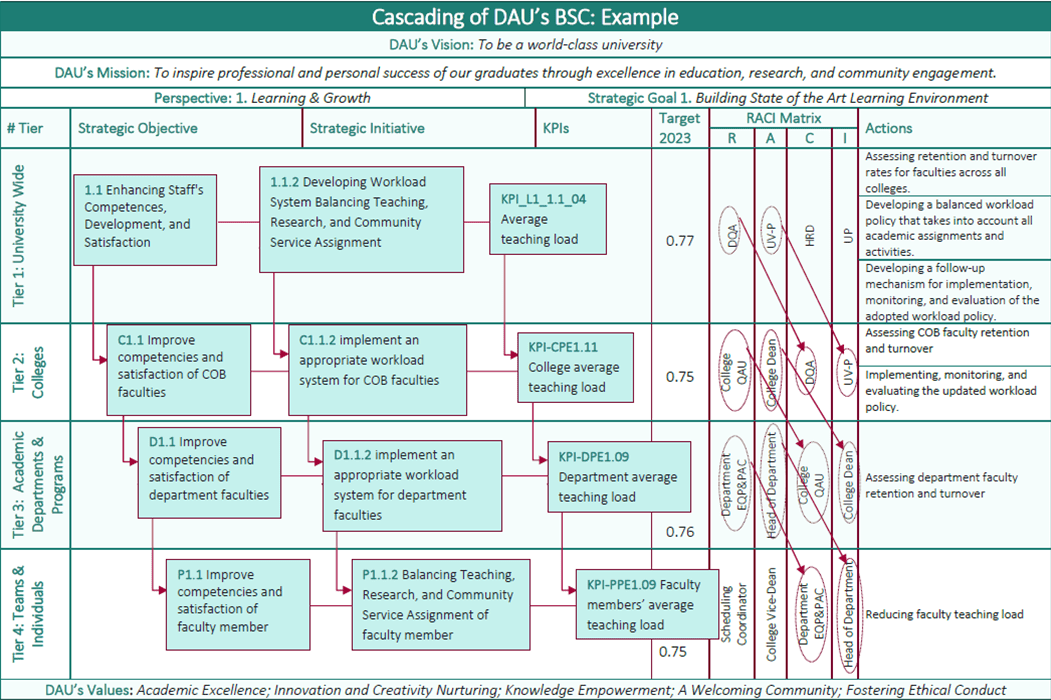DAU’s Strategic Plan Cascading Tiers
Cascading Key Points
For DAU’s strategic plan to be effective, strategic goals and objectives, and performance indicators must be consistent across levels of the organization. In DAU’s BSC, consistency is achieved through cascading. In cascading, strategic objectives and performance indicators are taken from the corporate and cascaded down to business units, departments, and individuals.
–
The following key points were taken into consideration in DAU’s Balanced scorecard cascading implementation:
- Cascading is done by goals and objectives: support units, colleges, departments, and teams develop their own scorecard and align their goals and objectives with DAU’s strategy map. At their levels, they can map additional goals and objectives using the strategy map.
- Keeping cause-and-effect connections: Cause-and-effect connections between objectives and goals should be maintained at different Tiers. Without this, the next level’s strategy map will be useless and achieving coherence between goals, objectives, initiatives and actions at different tires cannot be achieved.
- All objectives should have responsible: Delegating responsibility for achieving objectives is fundamental to cascading BSC. The top tier of managers sets strategic goals, objectives, and initiatives. The next tier of managers interprets these objectives in terms of narrower, more specific objectives to assume responsibility for, and so on for the following tier managers.
- Cascading is a bidirectional process with a discussion origin: Scorecards should be cascaded to the lower levels for the purpose of the reporting (or even direct control), at the same time, the top manager scorecard must aggregate the values from lower-level scorecards and present the required information for the decision-makers.
- Establish a hard connection by indicators: Cascading KPIs makes sense when lower levels are scaled copies of the parent level. This makes monitoring and accountability easier and logical.
–
DAU’s Cascading Tiers
|
Hierarchical Level |
DAU’s Entities |
# Cascading Tier |
|
1. Top Managers |
UP; UV-P; CEO; GDPD&QA |
Tier 1: University Wide |
|
2. Support Units |
HRD; DQA; DAR&SA; T&LU; ITD; DLS&L; PMD; O&M; RSU; CEU; DLS&L; T&PDU; M&ECD; IAU; RMC; CEI&KT; SP&ESC; FD |
|
|
3. Colleges |
University Preparatory Program; College of Business Administration; College of LAW; College of Architectural Engineering and Digital Design; College of Medicine; College of Dentistry; College of Pharmacy and Applied Medical Sciences; College of Business Administration; and College of LAW |
Tier 2: Colleges |
|
4. Academic Departments |
Marketing Department; Human Resources Management Department; Finance & Banking Department; Accounting Department; Basic Medical Science Department; Clinical Medical Sciences Department; Medical Education Department; Department of Dentistry; Architecture Department; Interior Design Department; Graphic Design Department; Department of Bachelor’s Degree Program in Law; Department of Master’s Degree Program in Law; Nursing Department; and Respiratory Therapy Department |
Tier 3: Academic Departments & Programs |
|
5. Academic Programs |
Bachelor of Marketing; Bachelor of HRM; Bachelor of Finance & Banking; Bachelor of Accounting; Bachelor of Law; Bachelor of Architectural Engineering; Bachelor of Interior Design; Bachelor of Graphic Design; Bachelor of Medicine; Bachelor of Dentistry; Bachelor of Nursing; Bachelor of Respiratory Therapy; Master of Business Administration; Master of Management Information System; Master of Project Management; Master of Public Law; and Master of Private Law |
|
|
7. Teams and Individuals |
Teaching Staff & Administrative Staff |
Tier 4: Teams & Individuals |
–


 College of Medicine
College of Medicine College of Dentistry
College of Dentistry College of Architectural Eng & Digital Design
College of Architectural Eng & Digital Design College of Business Administration
College of Business Administration College of Law
College of Law University Preparatory Program
University Preparatory Program College of Pharmacy and Applied Medical Sciences
College of Pharmacy and Applied Medical Sciences Student Affairs Department
Student Affairs Department General Directorate of Planning, Development, and Quality Assurance
General Directorate of Planning, Development, and Quality Assurance